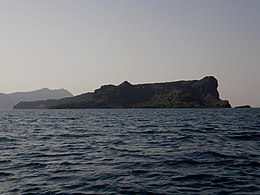| Nickname: "Old Burnt Island" | |
|---|---|
 | |
| Geography | |
| Location | Mediterranean Sea |
| Coordinates | 36°23′51″N 25°22′46″E / 36.39750°N 25.37944°E / 36.39750; 25.37944 |
| Total islands | 1 |
| Administration | |
| Greece | |
Palea Kameni, also known as Palia Kameni, is a volcanic island within the Santorini Caldera. The island was formed by a series of volcanic eruptions that formed large deposits of pumice and dacite lavas. The island's name translates to "Old Burnt Island". Palea Kameni is a private island, it was inhabited until it was bought in 1899 and sold in 1975.
History
Palea Kameni was formed by a series of eruptions between 197 BCE and 47 CE. The appearance of the island was noted in the journal of Roman historian Cassius Dio, who wrote "This year a small islet, hitherto unknown, made an appearance close to the island of Thera." No further activity is known from the island until 726, when the island suffered a submarine explosive eruption of pumice, and lava. Volcanic activity then ceased again until the 1570s, when the development of Palea's sister island Nea Kameni caused increased volcanic activity to be reported. Other ancient authors note that it arose from the sea in 197 BCE and was given the name Hiera (Ancient Greek: Ἱερά), a name frequently given in antiquity to volcanic mountains. This fact is stated by Eusebius, Justin, Strabo, and Plutarch. It is related by Strabo that flames burst out of the sea for four days, and that an island was formed 12 stadia or 1.5 miles (2.4 km) in circumference.
The island lies to the southwest of Nea Kameni. Though the island is for the most part uninhabited, several structures (including a small church) are located on the island. Due to the lack of a good harbor, most recreational watercraft do not stop at the island, though tourists can swim to the island from nearby Nea Kameni. Like the larger island to its east, Palea Kameni is sparsely vegetated with succulent plants. A herd of goats is present on the island, as is a single inhabitant, Sostice Arvanitis. The island also contains a hot spring.
References
- ^ "Visit the Volcano – Santorini.net". www.santorini.net. Retrieved 2018-07-13.
- ^ "The Kameni Islands". www.decadevolcano.net. Retrieved 2018-07-13.
- "Thera (Cyclades) 2 Santorini – Θήρα". topostext.org. Retrieved 2018-07-13.
- Preine, Jonas; Karstens, Jens; Hübscher, Christian; Druitt, Tim; Kutterolf, Steffen; Nomikou, Paraskevi; Manga, Michael; Gertisser, Ralf; Pank, Katharina; Beethe, Sarah; Berthod, Carole; Crutchley, Gareth; McIntosh, Iona; Ronge, Thomas; Tominaga, Masako; Clark, Acacia; DeBari, Susan; Johnston, Raymond; Mateo, Zenon; Peccia, Ally; Jones, Christopher; Kletetschka, Günther; Metcalfe, Abigail; Bernard, Alexis; Chen, Hehe; Chiyonobu, Shun; Fernandez-Perez, Tatiana; Joshi, Kumar Batuk; Koukousioura, Olga; McCanta, Molly; Morris, Antony; Polymenakou, Paraskevi; Woodhouse, Adam; Yamamoto, Yuzuru; Wang, Kuo-Lung; Lee, Hao-Yang; Li, Xiaohui; Papanikolaou, Dimitrios (25 March 2024). "Hazardous explosive eruptions of a recharging multi-cyclic island arc caldera". Nature Geoscience. 17 (4): 323–331. doi:10.1038/s41561-024-01392-7.
- Euseb. Chron. p. 144, Olymp. 145. 4; Justin, 30.4; Plut. de Pyth. Or. 11. p. 399; Strabo. Geographica. Vol. i. p. 57. Page numbers refer to those of Isaac Casaubon's edition.
- Schorr, Tobias. "Sostis Arvanitis: Der Einsiedler Sostis Arvanitis hat die Vulkaninsel Palia Kameni in einen kleinen Garten verwandelt. ER lebt dort alleine mit seinen Ziegen, Hühnern und einem Schäferhund. Er fährt mit seinem Boot kleine Gruppen zu seiner Insel". www.vulkaninsel-santorin.de. Retrieved 2018-07-13.
- "Volcano and Hot Springs in Santorini island". Greeka.com. Retrieved 2018-07-13.
![]() This article incorporates text from a publication now in the public domain: Smith, William, ed. (1854–1857). "Thera". Dictionary of Greek and Roman Geography. London: John Murray.
This article incorporates text from a publication now in the public domain: Smith, William, ed. (1854–1857). "Thera". Dictionary of Greek and Roman Geography. London: John Murray.
This volcanology article is a stub. You can help Misplaced Pages by expanding it. |